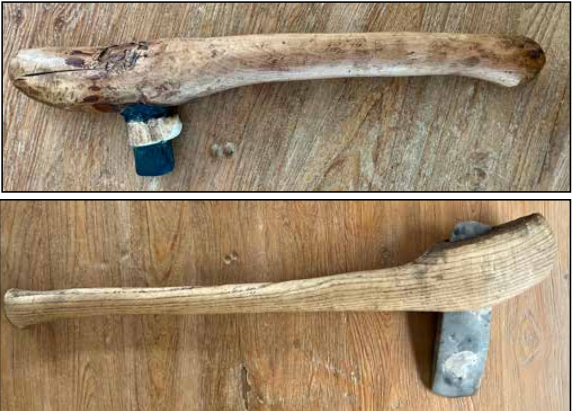|
Educational Artifact Displays
|
by William Moody |
| Central States Archaeological Societies 2025 October Journal |
West Tisbury, Massachusetts |
| |
|
|
This excerpt from "Educational Artifact
Displays" published
in the 2025 Central States Archaeological Societies 2025
October Journal
Read the complete column in the Central States
Archaeological Societies 2025
October Journal which can be purchased on-line after March 2026 |
 |
Figure 1.The top face of the cache of five chisels.
|
As avocational archaeologists or collectors, when we have occasions to share
our collections with people who might be interested in seeing the artifacts,
we often find that they naturally want to know more. Most people would usually
recognize an “arrowhead,” but what about many of the other stone
implements? What exactly are they? And then, how were they used? This is
when we are provided with the additional opportunity to offer some helpful
education on the subject.
As we know, so much of the archaeological record is comprised primarily
of stone implements because organic materials, such as wood or bone, are
not well preserved over time. This means that it is very rare to see exactly
how a stone tool or weapon was actually utilized—how it may have been
hafted for its working purpose. There have, of course, been rare exceptions
that give great insights into prehistoric activities. A hafted celt, for
example, still in its wooden handle was found a number of years ago off the
south coast of Massachusetts. It was submerged in a mud flat and discovered
by a fisherman raking for clams. The fisherman carefully wrapped it in wet
burlap and donated this exceptional artifact to the Massachusetts Archaeological
Society. After undergoing a painstaking process by professional archaeologists,
the wooden handle was treated to prevent any further deterioration. It has
since been displayed for many years at the Society’s museum.
Yet when someone sees a fine polished stone celt in a collection without
its original haft, he may not be able to easily imagine how it could have
been utilized. In earlier times, for example, polished stone celts were thought
by some cultures to have fallen from the sky as thunderbolts and were often
imbued with sacred, magical, or healing powers. Little was known of their
actual use. The author has found that having some artifacts displayed with
replicated hafts or handles has been especially informative for others.
This has been of even greater interest when a person is allowed to pick up
the hafted stone tool and “feel” how it was used. (Something
that is almost never possible with public museum displays).
Some examples in the author’s collection are shown in the accompanying
photographs (Figs 1-5). All of the replicated hafts illustrated here were
made by Richard Parker of Massachusetts, who has great expertise in replicating
stone tools and then subsequently experimenting with them. Parker once created
a group of stone axes, gouges, and celts; hafted them using traditional
methods and materials; and then chopped down a large tree and made an entire
dugout canoe!
Figures 1 and 2 show two hafted celts. The first example (Fig. 1) is a small
celt that the author found along an eroded shoreline. The author asked Dick
Parker to create a working haft. Parker modeled this ...
Read other great columns in the Central States Archaeological Societies 2025
October Journal which can be purchased on-line after March 2026
|
|




